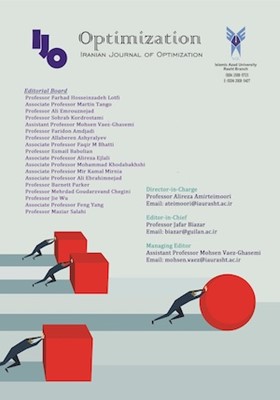Efficiency Evaluation of Economic Enterprise in Presence of Interval Undesirable and Negative Data
Subject Areas : Operation ResearchMahnaz Maghbouli 1 * , Mahdi Eini 2 , Farhad Taher 3 , Fatemeh Ghomanjani 4
1 - هیات علمی گروه ریاضی، دانشگاه آزاد اسلامی واحد ارس، جلفا، ایران.
2 - هیات علمی
3 - دانشگاه آزاد اسلامی، واحد تبریز، گروه ریاضی کاربردی
4 - موسسه آموزش عالی کاشمر، کاشمر، ایران
Keywords: Data Envelopment Analysis (DEA), Negative data, Efficiency, Interval data, Undesirable outputs,
Abstract :
Data envelopment analysis (DEA) as a non-parametric method has covered a wide range of applications in measuring comparative efficiency of decision making units (DMUs) with multiple incommensurate inputs and outputs. The standard DEA method requires that all input and output variables be known as semi positive. In many real situations, the presence of undesirable and even negative data are inevitable. In DEA literature there have been various approaches to enable DEA to deal with negative data. On the other hand, the structure of interval data has recently attracted considerable attention among DEA researchers. According to importance of interval data, this paper proposes a radial measure which permits the presence of undesirable and negative data with interval structure. The proposed model can evaluate the efficiency of all DMUs and leads to improve the inefficient unit with interval negative and undesirable data. To elucidate the details of the proposed method an illustrative example of a private bank in IRAN explores the applicability of the proposed method.
Amirtiemoori, A., & Kordrostami, S. (2013). An alternative clustering approach: a DEA-based procedure. Optimization, 62(2), 227-240.
Asmild, M., & Rastor, J. T. (2010). Slack free MEA and RDM with comprehensive efficiency measures. Omega, 38(6), 475-483.
Banker, R. D., Charnes, A., & Cooper, W. W. (1984). Some models for estimating technical and scale inefficiencies in data envelopment analysis. Management science, 30(9), 1078-1092.
Charnes, A., Cooper, W. W., & Rhodes, E. (1978). Measuring the efficiency of decision making units. European journal of operational research, 2(6), 429-444.
Despotis, D. K., & Smirlis, Y. G. (2002). Data envelopment analysis with imprecise data. European Journal of Operational Research, 140(1), 24-36.
Emrouznejad, A., Anouz, A. L., & Thanassoulis, E. (2010). A semi-oriented radial measure for measuring the efficiency of decision making units with negative data, using DEA. European Journal of Operational Research, 200(1), 297-304.
Esmaeilzadeh, A., & Hadi-Vencheh, A. (2015). A new method for complete ranking of DMUs. Optimization, 64(5), 1177-1193.
Eyni, M., Tohidi, G., & Mehrabeian, S. (2017). Applying inverse DEA and cone constraint to sensitivity analysis of DMUs with undesirable inputs and outputs. Journal of the Operational Research Society, 68(1), 34-40.
Fare, R., & Grosskopf, S. (2003). Nonparametric productivity analysis with undesirable outputs: comment. American Journal of Agricultural Economics, 85(4), 1070-1074.
Fare, R., Grosskopf, S., Lovell, C. K., & Pasurka, C. (1989). Multilateral productivity comparisons when some outputs are undesirable: a nonparametric approach. The review of economics and statistics, 90-98.
Halkos, G., & Petrou, K. N. (2019). Treating undesirable outputs in DEA: A critical review. Economic Analysis and Policy, 62, 97-104.
Jahanshahloo, G. R., Lotfi, F. H., Malkhalifeh, M. R., & Namin, M. A. (2009). A generalized model for data envelopment analysis with interval data. Applied Mathematical Modelling, 33(7), 3237-3244.
Jahanshahloo, G. R., LOTFI, F. H., SHOJA, N., TOHIDI, G., & RAZAVYAN, S. (2005). Undesirable inputs and outputs in DEA models. Applied Mathematics and Computation, 169(2), 917-925.
Khalili-Damghani, K., Tavana, M., & Haji-Saami, E. (2015). A data envelopment analysis model with interval data and undesirable output for combined cycle power plant performance assessment. Expert Systems with Applications, 42(2), 760-773.
Kuosmanen, T., & Matin, R. K. (2011). Duality of weakly disposable technology. Omega, 39(5), 504-512.
Lotfi, F. H., Jahanshahloo, G. R., Namin, M. A., & Irvani, Z. (2007). A generalized model in presence undesirable factors. In International Mathematical Forum (Vol. 2, No. 9, pp. 403-412).
Piao, S. R., LI, J., & Ting, C. J. (2019). Assessing regional environmental efficiency in China with distinguishing weak and strong disposability of undesirable outputs. Journal of Cleaner Production, 227, 748-759.
Portela, M. C. A. S., Thanassoulis, E., & Simpson, G. (2004). A directional distance approach to deal with negative data in DEA: An application to bank branches. Journal of Operational Research Society, 55(10), 1111-1121.
Sahoo, B. K., Khoveyn, M., Eslami, R., & Chaudhury, P. (2016). Returns to scale and most productive scale size in DEA with negative data. European Journal of Operational Research, 255(2), 545-558.
Seiford, L. M., & Zhu, J. (2002). Modeling undesirable factors in efficiency evaluation. European journal of operational research, 142(1), 16-20.
Sharp, J. A., Meng, W., & Liu, W. (2007). A modified slacks-based measure model for data envelopment analysis with ‘natural ’negative outputs and inputs. Journal of the Operational Research Society, 58(12), 1672-1677.
Shirazi, F., & Mohammadi, E. (2019). Evaluating efficiency of airlines: A new robust DEA approach with undesirable output. Research in Transportation Business & Management, 33, 100467.
Taher F, Daneshiyan B, Tohidi G, Lotfi F. H, Modarres F (2019). Estimating Undesirable Outputs and Desirable Inputs for Decision Making Units with Interval Data in Data Envelopment Analysis. Accept in Journal of the Operations Research Society of China (JORC).
Tao, X., Wang, P., & Zhu, B. (2016). Provincial green economic efficiency of China: A non-separable input–output SBM approach. Applied energy, 171, 58-66.
Yousefi, S., Alizadeh, A., Hayati, J., & Baghery, M. (2018). HSE risk prioritization using robust DEA-FMEA approach with undesirable outputs: a study of automotive parts industry in Iran. Safety science, 102, 144-158.
Zhou, Z., Xu, G., Wang, C., & Wu, J. (2019). Modeling undesirable output with a DEA approach based on an exponential transformation: An application to measure the energy efficiency of Chinese industry. Journal of Cleaner Production, 236, 117717.

